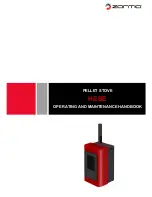
CLEMY
cod. 004770261 - 11/2008
27/80
GB
DE
6 INSTALLATION
6.1 INSTALLATION
PARAMETERS
To ensure correct stove operation it is necessary to fol-
low some fundamental rules regarding the
FLUE
, the
AIR INTAKE
and
INSTALLATION
.
(Ref. standard UNI 10683.
-
The
EXTERNAL AIR INTAKE
is essential to ensure
an appropriate fl ow of
COMBUSTION AIR
especially
if there are windows with double glazing and seals.
Drill a hole on one of the outside walls. If possible,
the hole should be behind or to the side of the ap-
pliance and should be fi tted with an anti-insect grille
(fi g. 6.1.1).
Standard UNI 1068 prohibits the drawing of combus-
tion air from garages or warehouses for combustible
material. The external intake hole for combustion
air must not be connected to the stove with a pipe.
If the room contains other heating equipment, the
combustion air intakes must ensure the volume of
air required for operation of all devices. If the room
where the stove is located includes one or more
extraction fans (exhaust hoods), combustion may
be poor due to lack of combustion air.
- The size of the
FLUE
must comply with TECHNICAL
SPECIFICATIONS. It is recommended to use fl ues
insulated preferably in a refractory material or stain-
less steel with a circular cross-section and smooth
internal walls. Flue cross-section should be kept
constant for its entire height. A minimum height of
3.5 ÷ 4 m is recommended (fi g. 6.1.2).
There should be a chamber for gathering solid materi-
als and any condensation beneath the smoke pipe
outlet. The characteristics of the fl ue pipe must be
compliant with the provisions of standards EN 10683
- EN 1856-1-2 - EN 1857 - EN 1443 - EN 13384-1-3
- EN 12391-1.
DETERIORATING
fl ues made with unsuitable ma-
terials (such as asbestos cement, galvanised steel,
etc., with a rough or porous internal surface) are
illegal and can jeopardise the correct operation of
the fi replace.
-
A
PERFECT DRAUGHT
is above all the result of
a fl ue that is clear of obstructions such as chokes,
horizontal sections or sharp angles; any axial dis-
placements should be at a maximum angle of 45°
in relation to the vertical axis (better still if it is only
30°). These displacements should preferably be
made near the chimney top.
-
The
SMOKE CONNECTION
between the fi replace
and fl ue should be done with specifi c pipes and
bends in rigid aluminated steel at least 2 mm thick,
or in 1 mm thick stainless steel that facilitate installa-
tion and also guarantee functionality and resistance.
It is forbidden to use fl exible metal and/or asbestos
cement pipes.
-
The
CHIMNEY
top shall be the
WINDPROOF
type
with an inside cross section equivalent to the fl ue
and with a smoke outlet passage section at least
DOUBLE
the internal one of the fl ue (fi g. 6.1.3).
- To avoid draught problems, each fi replace should
have its own fl ue. If there is more than one fl ue on
the roof, the others should be situated at a distance of
at least 2 metres and the stove’s chimney top should
be at least 40 cm
ABOVE
the others. If the chimney
tops are near each other install some dividing panels
6 INSTALLATION
6.1 INSTALLATIONSPARAMETER
Für einen einwandfreien Betrieb des Heizofens müssen
einige grundlegende Regeln befolgt werden, die sich
auf, den
RAUCHFANG
, die
LÜFTUNGSÖFFNUNG
und die
INSTALLATION
beziehen.
(Vgl. Norm UNI 10683).
-
Die
LÜFTUNGSÖFFNUNG
ist unerlässlich, um eine
angemessene Zufuhr von
VERBRENNUNGSLUFT
zu sichern. Dies gilt vor allem bei Vorhandensein
von Doppelfenstern und Abdichtungen. Stellen
Sie an einer Außenwand eine Öffnung mit einem
Durchmesser her. Die Öffnung muss sich möglichst
hinter oder seitlich des Gerätes befi nden und mit
einem Insektenschutzgitter versehen werden (Abb.
6.1.1).
Mit der Norm UNI 1068 wird die Zuführung der
Verbrennungsluft aus Garagen oder Brennmaterial-
Lagern untersagt. Die Öffnung zur Verbrennungsluft-
zufuhr darf nicht mittels Rohrleitung an den Heizofen
angeschlossen werden.
Falls im Raum noch weitere Heizgeräte aufgestellt
sind, müssen die Luftklappen der Verbrennungsluft
die für den einwandfreien Betrieb aller Vorrichtungen
nötige Luftmenge gewährleisten. Falls im Raum,in
dem der Heizofen aufgestellt ist, einer oder mehrere
Abzugsgebläse (Abzugshauben) vorhanden oder in
Betrieb sind, könnte durch die mangelnde Verbren-
nungsluft ein schlechter Heizofenbetrieb verursacht
werden.
- Die Abmessungen des
RAUCHFANGS
müssen den
Angaben im allgemeinen DATENBLATT ENTSPRE-
CHEN. Es ist empfehlenswert, isolierte Rauchfänge
aus Schamotte oder Edelstahl mit rundem Quer-
schnitt und Innenwänden mit glatter Oberfl äche zu
verwenden. Der Durchmesser des Rauchfangs muss
über seine gesamte Länge gleich sein. Es wird eine
Mindesthöhe von 3,5-4 m empfohlen (Abb. 6.1.2).
Es ist angebracht, unter der Mündung des Rauch-
kanals eine Kammer vorzusehen, in der Feststoffe
und eventuelle Kondensation aufgefangen werden.
Die Merkmale des Rauchfangs müssen dem Inhalt
der Normen EN 10683 - EN 1856-1-2 - EN 1857 - EN
1443 - EN 13384-1-3 - EN 12391-1 entsprechen.
BAUFÄLLIGE Rauchfänge aus ungeeignetem
Material (Asbestzement, verzinkter Stahl usw... mit
rauen und porösen Innenfl ächen) entsprechen nicht
den geltenden Gesetzen und beeinträchtigen den
einwandfreien Betrieb des Heizofens.
-
Ein
PERFEKTER RAUCHABZUG
wird vor allem
durch einen von Hindernissen, wie z.B. Verstop-
fungen, horizontalen Strecken und Kanten freiem
Rauchfang gewährleistet. Eventuelle Achsverschie-
bungen müssen einen schrägen Verlauf mit einem
max. Winkel von 45° zur Senkrechten, bzw. besser
noch 30°, haben. Diese Versetzungen sollten mög-
lichst in der Nähe des Schornsteins vorgenommen
werden.
-
Der
RAUCHANSCHLUSS
zwischen Heizofen und
Rauchfang muss mit geeigneten, starren Rohren und
Krümmungen aus mindestens 2 mm starkem Stahl
oder 1 mm starkem Edelstahl erfolgen. Dadurch wird
die Installation vereinfacht und ein einwandfreier
Betrieb bzw. Widerstandsfähigkeit garantiert. Der
Einsatz von biegsamen Metallrohren bzw. Rohren
aus Asbestbeton ist verboten.
















































